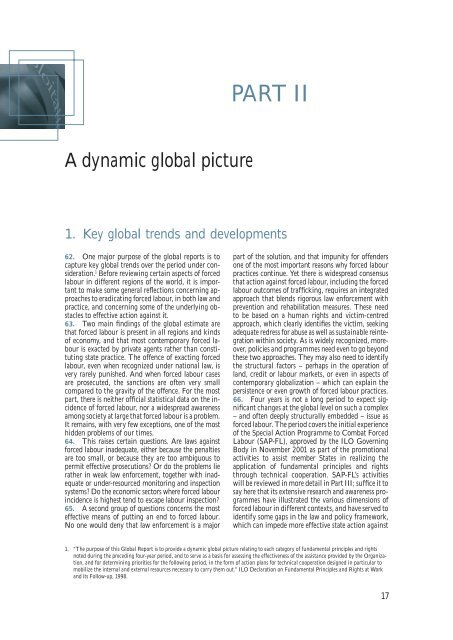A Global Alliance Against Forced Labour - International Labour ...
A Global Alliance Against Forced Labour - International Labour ...
A Global Alliance Against Forced Labour - International Labour ...
Create successful ePaper yourself
Turn your PDF publications into a flip-book with our unique Google optimized e-Paper software.
PART IIA dynamic global picture1. Key global trends and developments62. One major purpose of the global reports is tocapture key global trends over the period under consideration.1 Before reviewing certain aspects of forcedlabour in different regions of the world, it is importantto make some general reflections concerning approachesto eradicating forced labour, in both law andpractice, and concerning some of the underlying obstaclesto effective action against it.63. Two main findings of the global estimate arethat forced labour is present in all regions and kindsof economy, and that most contemporary forced labouris exacted by private agents rather than constitutingstate practice. The offence of exacting forcedlabour, even when recognized under national law, isvery rarely punished. And when forced labour casesare prosecuted, the sanctions are often very smallcompared to the gravity of the offence. For the mostpart, there is neither official statistical data on the incidenceof forced labour, nor a widespread awarenessamong society at large that forced labour is a problem.It remains, with very few exceptions, one of the mosthidden problems of our times.64. This raises certain questions. Are laws againstforced labour inadequate, either because the penaltiesare too small, or because they are too ambiguous topermit effective prosecutions? Or do the problems lierather in weak law enforcement, together with inadequateor under-resourced monitoring and inspectionsystems? Do the economic sectors where forced labourincidence is highest tend to escape labour inspection?65. A second group of questions concerns the mosteffective means of putting an end to forced labour.No one would deny that law enforcement is a majorpart of the solution, and that impunity for offendersone of the most important reasons why forced labourpractices continue. Yet there is widespread consensusthat action against forced labour, including the forcedlabour outcomes of trafficking, requires an integratedapproach that blends rigorous law enforcement withprevention and rehabilitation measures. These needto be based on a human rights and victim-centredapproach, which clearly identifies the victim, seekingadequate redress for abuse as well as sustainable reintegrationwithin society. As is widely recognized, moreover,policies and programmes need even to go beyondthese two approaches. They may also need to identifythe structural factors – perhaps in the operation ofland, credit or labour markets, or even in aspects ofcontemporary globalization – which can explain thepersistence or even growth of forced labour practices.66. Four years is not a long period to expect significantchanges at the global level on such a complex– and often deeply structurally embedded – issue asforced labour. The period covers the initial experienceof the Special Action Programme to Combat <strong>Forced</strong><strong>Labour</strong> (SAP-FL), approved by the ILO GoverningBody in November 2001 as part of the promotionalactivities to assist member States in realizing theapplication of fundamental principles and rightsthrough technical cooperation. SAP-FL’s activitieswill be reviewed in more detail in Part III; suffice it tosay here that its extensive research and awareness programmeshave illustrated the various dimensions offorced labour in different contexts, and have served toidentify some gaps in the law and policy framework,which can impede more effective state action against1. “The purpose of this <strong>Global</strong> Report is to provide a dynamic global picture relating to each category of fundamental principles and rightsnoted during the preceding four-year period, and to serve as a basis for assessing the effectiveness of the assistance provided by the Organization,and for determining priorities for the following period, in the form of action plans for technical cooperation designed in particular tomobilize the internal and external resources necessary to carry them out.” ILO Declaration on Fundamental Principles and Rights at Workand its Follow-up, 1998.17
















